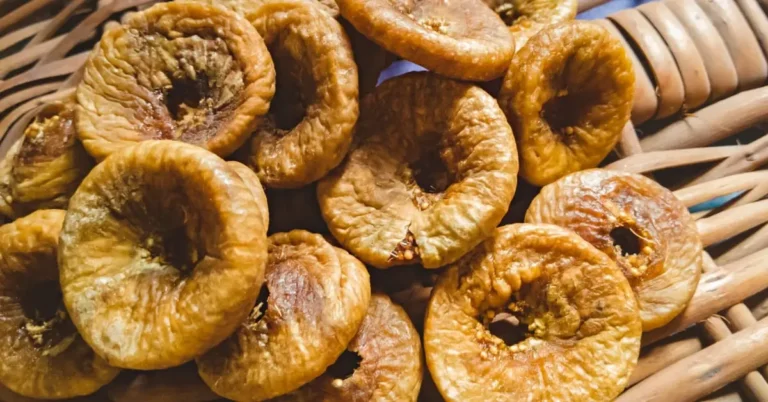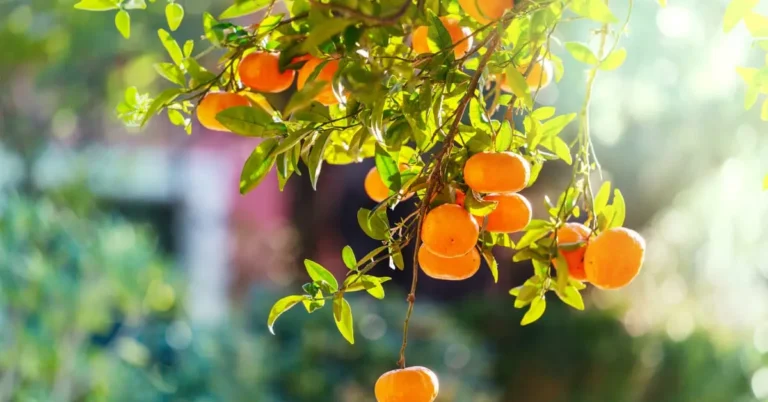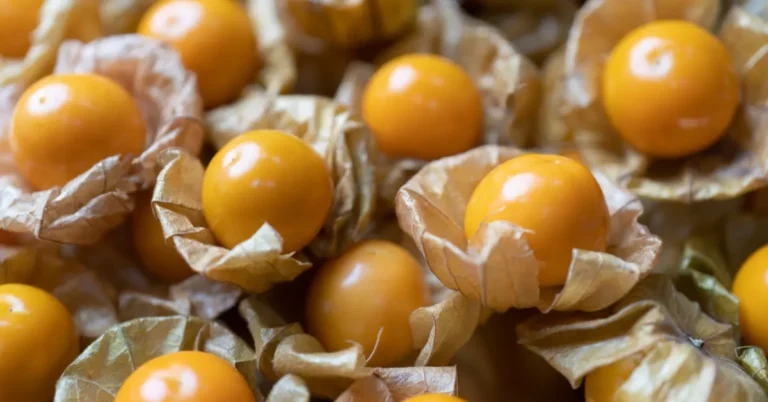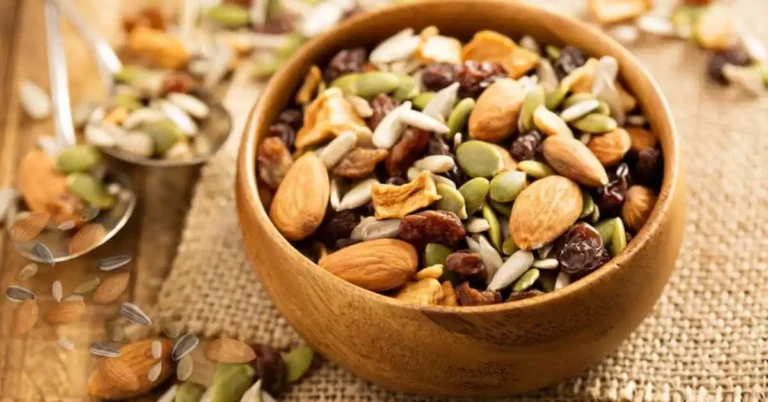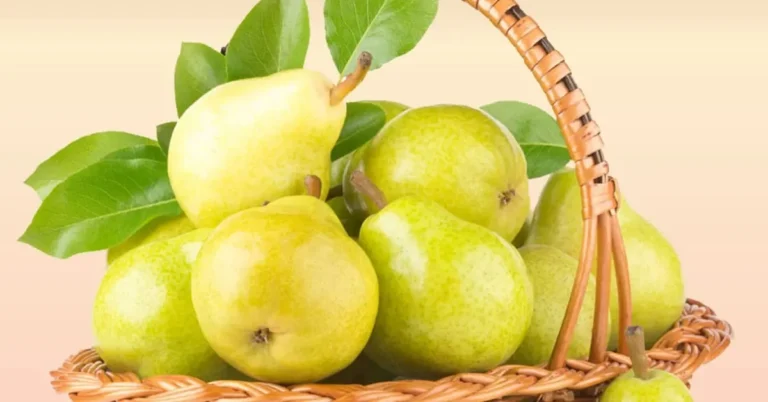60 Yummy Foods That Are Pink (Pink Foods)
Enjoy the pleasure of eating foods that are pink. These pink delights are not only pretty but also packed with health benefits. Easy to find and fun to eat, pink foods, like strawberries and salmon, add color and nutrition to your meals. This simple guide will help you explore and enjoy a range of pink foods that are both tasty and good for you.
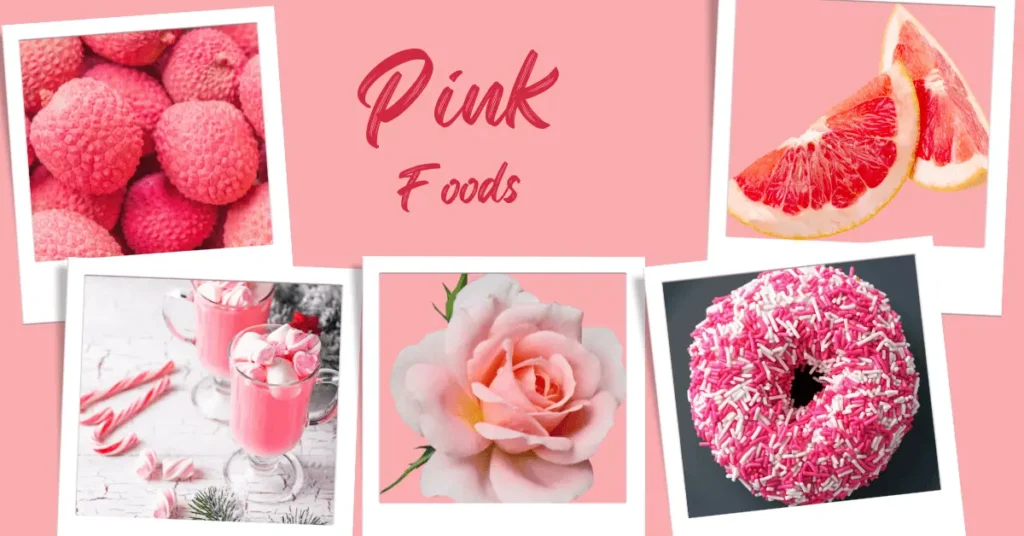
The Magic Behind Pink Food:
Have you ever wondered what gives foods their delightful pink color? It’s all thanks to natural compounds called anthocyanins and betalains. While they originate from different sources, these compounds share a common purpose – giving your favorite foods that are pink color. Not only do they make your plate more attractive, but they also provide a burst of antioxidants to combat inflammation and diseases.
List Of 60 Foods That Are Pink (Pink Foods)
Here is the list where you will see 60 foods that are pink.
Which Vegetables are Pink?
Pink vegetables are prevalent. The next time you buy vegetables for the week, keep an eye out for these.

1. Beets:
Beets, with their vibrant colors from deep pink to golden and striped, are rich in antioxidants and essential nutrients like folate, manganese, and potassium. The herbal pigments, called betalains, contribute to their unique colorings and are related to anti-inflammatory and antioxidant benefits.
2. China Rose Radish:
China Rose Radishes are characterized by their vibrant pink to rose-colored skin and crisp white flesh. China Rose Radishes, like different radish varieties, are low in energy and have an excellent supply of vitamin C. These radishes are typically utilized in salads, in which their vibrant color provides visual appeal.
3. Boniato Sweet Potato:
Boniato candy potato, scientifically called Ipomoea batatas, is a sweet potato famous in Latin American and Caribbean cuisines. Boniato sweet potatoes have mild brown to pinkish skin and white to cream-colored flesh. They offer a nutritious choice for those seeking extra vitamins and minerals.
4. Clancy Potato:
Clancy Potatoes are known for their distinctive rosy pink to deep red skin, which immediately sets them apart from more common potato varieties. The flesh inside is a warm white, providing a visually appealing contrast. With their creamy texture, Clancy Potatoes are especially suitable for mashed potatoes.
5. Chinese Pink Celery:
Chinese Pink Celery, scientifically known as Apium graveolens, is a unique variety of celery with distinctive features. It is recognized for its vibrant pink or light purple stems and leaves. It contains essential nutrients such as vitamins K, C, and potassium. Store it in the refrigerator, preferably in the crisper drawer, to maintain its crispness and freshness.
6. Japanese Pink Mizuna:
Japanese Pink Mizuna, scientifically known as Brassica rapa var. japonica, is a unique and visually appealing leafy green vegetable. Japanese Pink Mizuna is characterized by its fringed or serrated leaves with vibrant pink or purplish color. Mizuna has a mild and slightly peppery flavor, similar to other mustard greens.
Graph below illustrate Pink Foods:

7. Highland Burgundy Potato:
The Highland Burgundy Potato, scientifically known as Solanum tuberosum, is a unique potato variety known for its distinctive appearance and culinary qualities. It is recognized for its striking appearance with deep burgundy or purple skin and vibrant pink to maroon flesh. These potatoes have a rich, nutty flavor, and their texture is firm and waxy when cooked.
8. Kerrs Pink Potato:
It has a distinctive appearance with light pink to pale reddish-brown skin. The flesh of these potatoes is typically pale yellow. Due to their floury texture, Kerrs Pink Potatoes are often used to make mashed potatoes and baked potatoes in various potato-based dishes. They also contain some dietary fiber, vitamins, and minerals.
9. Mountain Rose Potato:
It is renowned for its vibrant and eye-catching appearance, featuring deep pink to reddish-purple skin. It has a mild and earthy flavor, complementing a variety of dishes. Store them in a cool, dark place away from direct sunlight to maintain their color and prevent sprouting.
10. Ornamental Cabbage and Kale:
Ornamental Cabbage and Kale showcase large, frilly leaves forming rosette shapes. Ornamental Cabbage and Kale thrive in well-drained soil and prefer full sun to partial shade. Regular watering and protection from extreme temperatures contribute to their overall health and appearance.
11. Pink Beauty Radish:
It is known for its round to oval shape and vibrant pink skin, adding a pop of color to various dishes and often used as a garnish. It also contains small amounts of fiber and other essential nutrients.
12. Pink Radicchio:
Its vibrant pink-to-red hues characterize a compact head of crisp leaves. It is low in calories and a good source of fiber, vitamins, and minerals.
13. Pusa Gulabi Radish:
Pusa Gulabi Radish features vibrant pink skin, mild flavor, and crisp texture. Ideal for salads and garnishes, its unique color adds visual appeal. Rich in vitamin C, it brings both taste and aesthetics to culinary creations.
14. Rainbow Carrots:
Rainbow Carrots are a colorful and diverse carrot variety in various hues such as orange, purple, yellow, and red. These vibrant carrots offer a sweet and crunchy flavor, making them a visually appealing and tasty addition to salads, side dishes, and snacks. Rich in antioxidants and nutrients, rainbow carrots enhance the culinary experience and provide a spectrum of health benefits.
15. Rose Finn Fingerling Potato:
It is a distinctive potato variety known for its slender, finger-like shape and unique pink or rose-colored skin. With a buttery texture and a slightly nutty flavor, it is well-suited for roasting, boiling, or adding a gourmet touch to various dishes.
16. Rhubarb:
Rhubarb is a perennial plant known for its tart-flavored stalks, often used in culinary applications as a fruit despite being a vegetable. The reddish to greenish-pink stalks are commonly employed in desserts, jams, and compotes, providing a distinctive sour taste. While the stalks are digestible, the leaves contain toxic oxalic acid. Rhubarb is rich in vitamins and minerals, adding flavor and nutritional value to various dishes.
17. Swiss Chard:
It is scientifically known as Beta vulgaris L.var.cicla is a leafy green vegetable with vibrant, colorful stems. Both the leaves and stems are digestible, offering a slightly bitter taste. Commonly used in salads, sautés, or as a side dish, Swiss Chard is rich in vitamins, minerals, and antioxidants. Its versatility, and nutritional benefits make it a popular choice in various culinary creations, contributing flavor and vibrant hues to the plate.
18. Watermelon Radish:
With its striking appearance, Watermelon Radish features a green and white exterior but reveals a vibrant, magenta-colored interior when sliced. This radish variety offers a mild, slightly peppery flavor and often adds a colorful and crisp element to salads and garnishes. Packed with nutrients, the Watermelon Radish combines visual appeal with a refreshing taste in culinary dishes.
Which Fruits Are Pink?
Pink fruits are delicious and refreshing. Look at grapefruit, But if that’s the only one that comes to mind, you’ll find a ton of other pink fruits to eat daily!
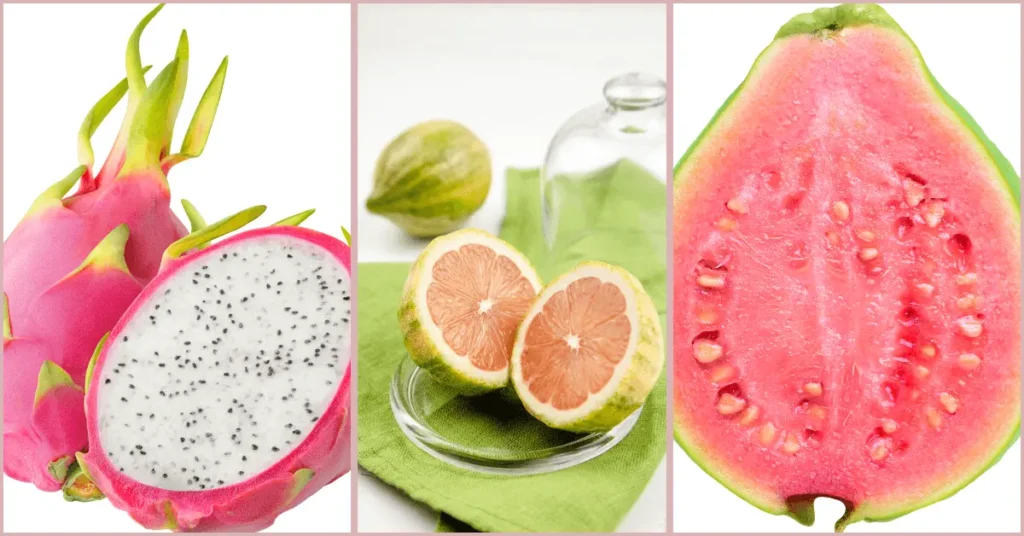
19. Brown Turkey Figs:
Brown Turkey Figs are a variety of figs known for their brownish-purple skin and sweet, flavorful taste. These figs have a tender and chewy texture, making them suitable for fresh consumption and culinary applications. Brown Turkey Figs are often enjoyed in salads, desserts, or as a standalone snack.
20. Cara Cara Oranges:
Cara Cara Oranges are navel oranges known for their distinct pinkish-red flesh, resulting from natural pigments like lycopene. With a sweet and sour flavor, they offer a unique citrus experience.
Prize the juiciness of Cara Cara Oranges as you commonly enjoy fresh, sliced, or in salads, providing a burst of color and a refreshing taste. Rich in vitamin C and antioxidants, these oranges are a nutritious addition to a balanced diet.
21. Black Mission Figs:
It is a dark purple to black-skinned fig variety known for its sweet and rich flavor. These figs have a tender, chewy texture and are often enjoyed fresh, dried, or incorporated into sweet and savory dishes.
22. Golden Globe Pomegranate:
Golden Globe Pomegranate is a specific variety known for its round shape, vibrant yellow skin, and ruby-red arils. These pomegranates, prized for their sweet-tart flavor, enhance fresh consumption and juicing and add color and taste to salads and desserts.
23. Dragon Fruit:
Dragon Fruit, also known as pitaya or pitahaya, is a tropical fruit with a unique appearance. It features bright pink or yellow skin; its flesh can be white, red, or magenta, speckled with tiny black seeds. Besides its appealing flavor, dragon fruit is rich in antioxidants, vitamins, and fiber, making it a nutritious choice for a vibrant and exotic culinary experience.
24. Heirloom Tomatoes:
Several heirloom tomato varieties boast a delightful pink tint. When given a choice, consider selecting heirloom tomatoes over grocery stores’ more commonly available types. They add flavor to dishes, and heirloom tomatoes are packed with vitamins C and A, offering a nutritious and delicious choice for culinary enthusiasts.
25. Guava:
Guava is a tropical fruit known for its sweet and fragrant flavor. With a distinctive aroma and a range of varieties, guavas can have white, pink, or red flesh, each offering a unique taste. Typically eaten fresh, juiced, or used in jams and desserts, guavas are rich in vitamin C, dietary fiber, and antioxidants.
26. Hidden Rose Apple:
Hidden Rose Apple, scientifically known as Malus domestica, features a distinctive pink flesh concealed beneath a green skin. This apple variety offers a sweet and slightly tart flavor, making it a unique and visually appealing choice for fresh consumption or culinary creations. Rich in fiber and antioxidants, the Hidden Rose Apple combines taste and nutritional benefits in its vibrant and rosy-hued profile.
27. Java Apple:
Java Apple, also known as Syzygium samarangense or rose apple, is a tropical fruit with a bell-shaped appearance and smooth, waxy skin. It comes in various colors, such as red, green, or yellow, and tastes crisp and mildly sweet. Rich in vitamins and low in calories, Java Apple is enjoyed fresh, sliced, or used in salads, providing a refreshing and nutritious addition to tropical cuisines.
28. Koshu Grapes:
Koshu Grapes, native to Japan, is a unique grape variety in winemaking. Known for their pale, golden color and distinct flavor profile, Koshu Grapes produces crisp and aromatic wines. With a balance of sweetness and acidity, Koshu wines are gaining popularity in Japan and internationally, offering a refreshing and elegant option for wine enthusiasts.
29. Loganberry:
The Loganberry is a hybrid berry, a cross between a raspberry and blackberry, known for its dark red to purplish-black color. With a sweet-tart flavor, it is commonly used in jams, jellies, and desserts. With a rich history, the Loganberry adds a unique twist to culinary creations, combining the best qualities of its parent berries.
30. Lilly Pilly Berries:
Lilly Pilly berries, scientifically known as Syzygium spp, are small, brightly colored fruits native to Australia. With a sweet-tart flavor, these berries are used in jams, jellies, and desserts. Beyond their culinary uses, Lilly Pilly berries are appreciated for their ornamental value, as they grow on attractive evergreen shrubs.
31. Lychee:
Lychee, a tropical fruit with a rough, pink-red outer skin, is renowned for its sweet and fragrant white flesh. This exotic fruit is typically consumed fresh, offering a juicy and refreshing experience. Rich in vitamin C and antioxidants, lychee delights the taste buds and provides nutritional benefits.
32. Okinawa Pink Okra:
Okinawa Pink Okra is a distinctive variety known for its vibrant pink color. This vegetable features tender pods with a slightly sweet flavor, making it a unique and visually appealing dish addition.
33. Pink Banana:
Pink Banana, scientifically known as Musa velutina, is a tropical banana variety recognized for its unique pink color and smaller size than ordinary yellow bananas. While the flesh is white, the outer peel exhibits a striking pink or reddish color.
34. Pink Grapefruit:
It is a citrus fruit known for its sweet-tart flavor and a vibrant pink or reddish flesh. With a refreshing taste, this grapefruit variety is enjoyed fresh, juiced, or added to salads. Its distinct color and sour sweetness make it a popular choice for those seeking a flavorful and nutritious addition to their diet.
35. Pink Lady Apple:
Pink Lady Apple, or Cripps Pink, is a distinctive apple variety recognized for its bright pink or rosy skin. With a sweet-tart flavor and crisp texture, this apple is famous for fresh consumption, salads, and desserts.
36. Pink Lemonade Blueberries:
It is a unique blueberry variety known for its pinkish color and distinct sweet-tart flavor. These light pink berries make them visually appealing and perfect for adding a colorful touch to salads, desserts, or as a fresh snack.
37. Pink Lime:
Pink Lime, or Rangpur lime, is a citrus fruit with a small, round shape and a distinctive reddish-orange color. Despite its name, the fruit is not an actual lime but a hybrid of mandarin orange and citron. Pink Limes are prized for their tangy flavor, often used in culinary applications, cocktails, or as a zesty dish addition.
38. Pink Pearl Apple:
It is a unique variety celebrated for its vibrant pink or rosy flesh. Pink Pearl Apples are rich in fiber and antioxidants, providing a healthy and delicious culinary experience.
39. Pink Peppercorn:
Although not a peppercorn, Pink Peppercorn is a dried berry with a distinctive pink color and a mildly sweet, spicy flavor. Despite their name, they are not related to black or white pepper.
40. Pinkglow Pineapple:
It is scientifically known as Ananas comosus, a unique pineapple variety celebrated for its pink flesh and vibrant appearance. With a blend of sweetness and tartness, this pineapple offers a distinct flavor profile. Beyond its delicious taste, Pinkglow Pineapple is rich in vitamin C and antioxidants, making it a flavorful and nutritious tropical treat.
41. Pink Pomelo:
It is a citrus fruit characterized by its large size, pale green or yellow peel, and pink to reddish-pink flesh. Pink Pomelo is enjoyed fresh, in salads, or as a refreshing juice with a sweet and slightly sour flavor.
42. Pink Reliance Grapes:
It is a grape variety known for its pinkish-red skin and sweet, juicy taste. Rich in antioxidants and vitamins, they satisfy the palate and offer nutritional benefits, making them a popular choice among grape enthusiasts.
43. Pink Satin Pomegranate:
Its specific variety is known for its unique pinkish-red skin and juicy, ruby-red arils. With a sweet and slightly tart flavor, this Pomegranate adds color and taste to salads, desserts, and beverages.
44. Pink Variegated Eureka Lemon:
The lemon variety is notable for its distinctive pink-striped yellow skin and pink-tinted flesh. This lemon offers a mildly tart and citrusy flavor, adding a unique twist to culinary creations.
45. Rainier Cherry:
Rainier Cherry is a premium variety known for its distinctive golden-yellow to bluish-red skin and sweet, succulent flesh. With a unique flavor profile combining sweetness and a hint of tartness, Rainier Cherries are often enjoyed as a delightful summer fruit.
46. Raspberries:
Sweet-tart raspberries, belonging to the rose family, are a pink berry with excellent nutritional value. Rich in fiber, manganese, and vitamin C, they also serve as a good source of vitamin K. These berries provide a deliciously vibrant addition to various dishes and contribute to a well-rounded and healthy diet.
47. Savagnin Rose Grapes:
Savagnin Rose Grapes is a grape variety that produces aromatic and flavorful wines. These grapes, characterized by their pinkish-red skin, are often used in winemaking to create rosé wines. With a balance of sweetness and acidity, Savagnin Rose Grapes contribute to the distinctive characteristics of their wines, offering a delightful and refreshing option for wine enthusiasts.
48. Sweet Pomegranate:
It is a variety known for its sweet and flavorful arils. These juicy, ruby-red seeds are commonly eaten fresh, added to salads, or used in various culinary applications. Pomegranates, including the Sweet variety, are rich in antioxidants, vitamins, and other nutrients, offering a delicious taste and potential health benefits.
Which beans are Pink?
Another way to include pink foods in your diet is through pink beans. Because they are filling, beans are a great plant-based protein for meals or side dishes.

49. Cranberry Beans:
It is also known as borlotti beans, which are distinguished by their speckled appearance, resembling cranberries. It’s medium to large with a splash of pink magenta. These beans have a creamy texture and a slightly nutty, mild flavor. Often used in Italian and Mediterranean cuisines, Cranberry Beans are versatile, and we can add them in soups, stews, salads, or as a side dish.
50. Pink Beans:
Pink Beans are a common bean known for their small size and light pink color. When cooked, these beans have a mild flavor and a smooth, creamy texture. They are a good source of protein, fiber, and essential nutrients, making them a nutritious addition to a balanced diet.
Do pink mushrooms exist?
It’s actual pink mushrooms exist. Avoid and refrain from consuming most pink mushrooms, except for one.
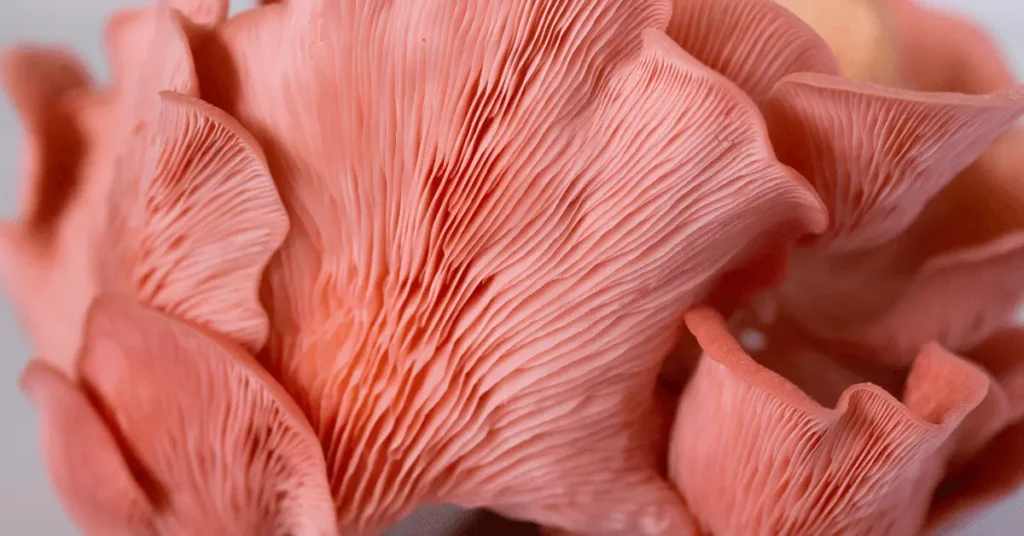
51. Pink Oyster Mushroom:
Pink Oyster Mushroom is a mushroom variety notable for its vibrant pink or salmon-colored cap. This digestible mushroom is valued not only for its unique appearance but also for its delicate, seafood-like flavor. Commonly used in Asian and vegetarian cuisines, Pink Oyster Mushrooms add a pop of color and a subtle taste to various dishes.
Which pink flowers are edible?
When you battle for your goal of better wellness, you can even consume pink blossoms. Although we wouldn’t advise grabbing a bouquet of pink flowers from a wedding or other occasion, you can safely consume these flowers.
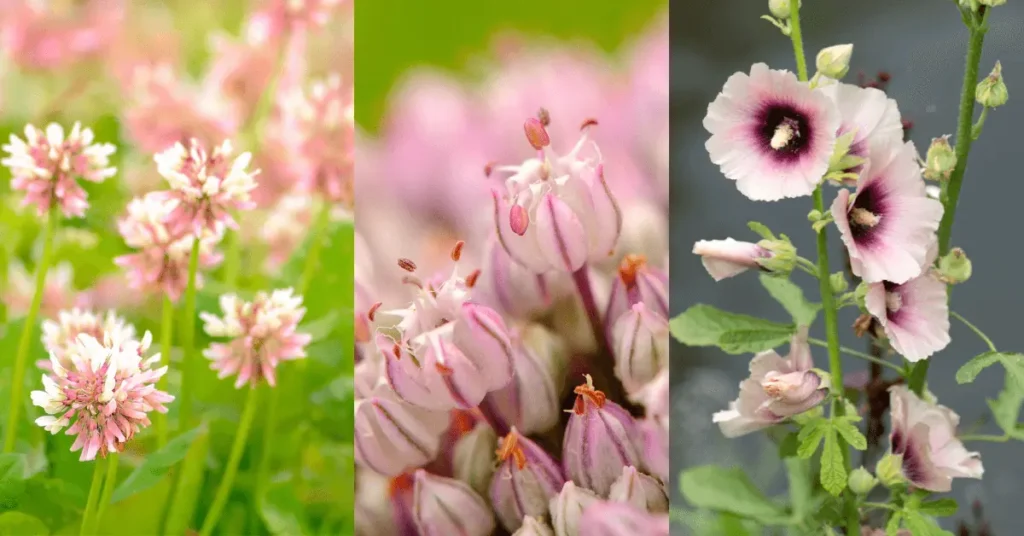
52. Clover Flowers:
Also known as trefoil, clover flowers are derived from Trifolium, a genus encompassing approximately 300 diverse plant species within the legume family. Native to Europe, these leaves and flowers are safely digestible. Whether consumed cooked or raw, you can relish clover flowers in various ways. Optimal for abundant protein and vitamins, fresh new leaves shine in salads or as cooked greens.
53. Garlic Flowers:
Garlic flowers, also known as garlic scapes or garlic tops, are the flowering shoots that emerge from garlic plants. These green, curly stems have a mild garlic flavor and are typically harvested before the garlic bulb fully matures. The stems and the flowers are digestible and can be used in cooking to impart a subtle garlic taste to dishes.
54. Hollyhock Petals:
Hollyhock petals are the delicate, colorful flowers of the hollyhock plant. These petals are digestible and can be used to add a touch of visual appeal and mild floral flavor to various dishes. Originating from the Alcea genus, hollyhocks are part of the mallow family.
55. Rose Petals:
Rose petals are the soft, fragrant petals of the rose flower, known for their enchanting aroma and delicate texture. Edible and often used in culinary applications, rose petals can add a subtle floral flavor to various dishes and beverages.
Care should be taken to use only petals from edible rose varieties, free from pesticides, for safe consumption. Whether fresh or dried, rose petals provide a romantic and aromatic touch to various gastronomic delights.
Pink Salt That Adds a Twist
56. Himalayan Pink Salt:
Himalayan Pink Salt is a type of rock salt mined from the Himalayan region and is often recognized for its distinctive pink color. This salt, composed of natural minerals, including iron, potassium, and magnesium, is believed to offer various health benefits. Himalayan Pink Salt is commonly used as a gourmet salt, imparting a unique flavor to dishes.
Prepared Food

57. Pink Ice Cream:
Pink ice cream is a delightful frozen treat that comes in various flavors, often showcasing a lovely shade of pink. Commonly enjoyed in cones, cups, or as part of decadent sundaes, this sweet and creamy dessert adds a burst of color to ice cream shops and dessert menus.
58. Pink Pasta:
Pink pasta is a vibrant and visually appealing dish known for its rosy color. The distinctive pink color is often achieved by incorporating ingredients like tomatoes, beets, or red peppers into the pasta sauce. Tomato-based sauces, when cooked with garlic, onions, and herbs, contribute to the striking color and the rich flavor profile of the dish. Beets can infuse the pasta with paint and a subtle earthy sweetness for those seeking a natural pink tint.
59. Pink Pancakes:
Pink pancakes are a delightful and colorful twist on the classic breakfast favorite. They can achieve their rosy color using natural ingredients such as beet puree, strawberry puree, or even a splash of pomegranate juice.
60. Pink Lemonade:
Pink lemonade is a refreshing and visually appealing beverage that adds color to your options. This iconic drink gets its pink color from adding fruit juices such as cranberry, strawberry, raspberry, or even a splash of grenadine.
Conclusion:
Adding pink foods ( foods that are pink) to your meals creates a visually stunning plate and boosts your antioxidant intake. These pink natural treasures offer a wide range of flavors and health benefits. Whether you’re looking to enhance the color palette of your dishes or explore new flavors, pink foods have something delightful to offer.

